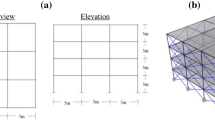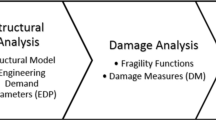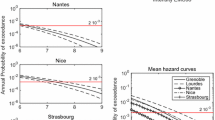Abstract
Estimating earthquake losses is an important issue for many private and public bodies. As a major stakeholder, insurers need realistic probable maximum loss (PML) values to foresee the possible losses they would face after a major earthquake and also to calculate optimal insurance premiums. Insurers generally use fragility curves to manage their portfolio by calculating overall PML values. There are, however, serious impacts of risk based PML estimation on earthquake insurance rates, and in this respect fragility curves, which represent regional losses rather than individual losses, could lead to suboptimal decisions. In this study, a rapid earthquake loss estimation methodology, which can be used even by the non-experts in earthquake engineering without conducting comprehensive structural analyses, is proposed for single-storey reinforced concrete industrial buildings based on parameters determined after investigating more than 80 industrial building projects in Turkey. 384 analytical structural loss estimation curves were obtained via the non-linear structural performance analysis method proposed in the 2007 Turkish Seismic Design Code. To provide a detailed evaluation of the proposed methodology’s performance, fragility curves representative of the structural types and the design levels of the buildings investigated were also developed. Finally, total insurance premiums corresponding to PML values of the inventory buildings were calculated, using the two aforementioned estimation methods and others previously published, by addressing issues such as reinsurance cost, capital cost and profit. Results reveal considerable differences in PML values and eventually earthquake insurance rates for the buildings investigated between the risk based structural loss estimation method and the existing methods, indicating possibilities for improved portfolio analysis and management tools.



















Similar content being viewed by others
References
Air Worldwide (AIR) (2011) Damage survey report, Tohoku, Japan Earthquake, http://www.airworldwide.com/Publications/Presentations/AIR-Surveys-Damage-from-the-Tohoku- Earthquake-and-Tsunami-(Summary-and-Slideshow)
Applied Technology Council (ATC) (1985) Earthquake damage evaluation for California, ATC 13. Redwood City, California
Applied Technology Council (ATC) (1996) Seismic evaluation and retrofit of concrete buildings, ATC 40. Redwood City, California
ASTM (2007) ASTM E2026–07, Standard guide for the estimation of probable loss to buildings from earthquakes, American Society for Testing and Materials, West Conshohocken, Pennsylvania
Bommer J, Spence R, Erdik M, Tabuchi S, Aydinoglu N, Booth E, Del Re D, Peterken O (2002) Development of an earthquake loss model for Turkish catastrophe insurance. J Seismol 6:431–446
DEE-KOERI (2003) Earthquake risk assessment for the Istanbul metropolitan area, Report prepared by Deparment of Earthquake Engineering. Kandilli Observatory and Earthquake Research Institute, Bogazici University Press, Istanbul, Turkey
Deniz A (2006) Estimation of earthquake insurance premium rates based on stochastic methods, MSc Thesis, Middle East Technical University, Ankara, Turkey
Deniz A, Yucemen MS (2009) Assessment of earthquake rates for the Turkish Catastrophe Insurance Pool. Georisk 3(2):67–74
Durukal E, Erdik M, Sesetyan K, Fahjan Y (2006) Building loss estimation for earthquake insurance pricing. In: Proceedings of the 1906 earthquake conference, CD, paper no: 1311, EERI, Oakland
Durukal E, Erdik M, Uçkan E (2008) Earthquake risk to industry in İstanbul and its management. Nat Hazards 44:199–212
Eren C (2014) Rapid loss estimation methodology for single storey reinforced concrete industrial buildings. Techn J Turk Chamb Civ Eng 25(2): 6275–6756 (in Turkish)
Faber MH (2007) Lecture notes: statistics and probability theory, exercises tutorial 7. http://www.ibk.ethz.ch/emeritus/fa/education/ss_statistics/07Statistik/Exercise_tutorial_7_SS07_web.pdf, Swiss Federal Institute of Technology Zurich, EZTH
Federal Emergency Management Agency (FEMA) (2001) HAZUS 99, earthquake loss estimation methodology, technical and user’s manual, Washington, DC
Federal Emergency Management Agency (FEMA) (2002) Rapid visual screening of buildings for potential seismic hazards: a handbook, FEMA 154, 2nd edn. Washington, DC
Fischinger M, Kramar M, Isakovic T (2008) Cyclic response of slender RC columns typical of precast industrial buildings. Earthq Eng 6:519–534
Freeman JR (1932) Earthquake damage and earthquake insurance: studies of a rational basis for earthquake insurance, also studies of engineering data for earthquake-resisting construction. McGraw-Hill, New York
Goda K, Yoshikawa H (2012) Earthquake insurance portfolio analysis of wood-frame houses in south western British Columbia, Canada. Earthq Eng 10:615–643
Gurpinar A, Abali M, Yucemen MS, Yesilcay Y (1978) Feasibility of obligatory earthquake insurance in Turkey, METU/ EERI Report No. 78-05, Ankara (in Turkish)
Karaesmen E (2001) Prefabrication in Turkey: facts and figures. Middle East Technical University, Ankara
Kayhan AH, Senel SM (2010a) Fragility curves for single story precast industrial buildings. Tech J Turk Chamb Civ Eng 21(4): 5161–5184 (in Turkish)
Kayhan AH, Senel SM (2010b) Fragility based damage assessment in existing precast industrial buildings: a case study for Turkey. Struct Eng Mech 34(1): 39–60
Kircher CA, Reitherman RK, Whitman RV, Arnold C (1997a) Estimation of earthquake losses to buildings. Earthq Spectra 13(4):703–720. Earthquake Research Institute, Oakland, California
Kircher CA, Nassar AA, Kustu O, Holmes WT (1997b) Development of building damage functions for earthquake loss estimation. Earthq Spectra 13(4). Earthquake Research Institute, Oakland, California
Kwak H, Kim J (2007) \(\text{ P }-\Delta \) effect of slender RC columns under seismic load. Eng Struct 29:3121–3133
National Institute of Building Science (NIBS), HAZUS (1997) Earthquake loss estimation methodology, HAZUS97: technical manual, report prepared for Federal Emergency Management Agency, Washington, DC
OECD (2011) Risk awareness, capital markets and catastrophic risks, policy issues in insurance, no. 14, OECD Publishing. doi: 10.1787/9789264046603-en
Posada M, Wood SL (2002) Seismic performance of precast industrial buildings in Turkey. In: 7th U.S. national conference on earthquake engineering, Boston
RMS (2000) Event report, Kocaeli, Turkey earthquake. http://www.rms.com/Publications/Turkey_Event.pdf
Steinbrugge KV (1982) Earthquake, volcanoes, and tsunamis: an anatomy of hazards. Skandia America Group, New York
Turkish Catastrophe Insurance Pool (TCIP) (2014) Tariffs and premium. http://www.tcip.gov.tr/zorunlu-deprem-sigortasi-tarife-ve-primler.html
Turkish Seismic Code (TSDC07) (2007) Specifications for structures to be built in seismic areas. Ministry of Public Works and Settlement, Ankara (in Turkish)
Whitman RV, Anagos T, Kricher CA, Lagorio HJ, Lawson RS, Schneider P (1997) Development of a national earthquake loss estimation methodology. Earthq Spectra 13(4). Earthquake Research Institute, Oakland, California
Yao TPJ (1981) Probabilistic methods for the evaluation of seismic damage of existing structures. Purdue University, West Lafayette
Yucemen MS (2005) Probabilistic assessment of earthquake insurance rates for Turkey. Nat Hazards 35:291–313
Yucemen MS, Yilmaz C, Erdik M (2008) Probabilistic assessment of earthquake insurance rates for important structures: application to Gumusova–Gerede motorway. Struct Saf 30:420–435
Zhao X, Wu Y, Leung A, Lam HF (2011) Plastic hinge length in reinforced concrete flexural members, the twelfth east Asia-Pacific conference on structural engineering and construction. Proc Eng 14:1266–1274
Acknowledgments
The authors are grateful to Professor Kutay Orakçal (Boğaziçi University), to Professor Alper İlki (İstanbul Technical University), and to Dr. Cüneyt Tüzün for their valuable contributions. The authors would also like to thank Tarık Tufan who has helped with structural simulations.
Author information
Authors and Affiliations
Corresponding author
Rights and permissions
About this article
Cite this article
Eren, C., Luş, H. A risk based PML estimation method for single-storey reinforced concrete industrial buildings and its impact on earthquake insurance rates. Bull Earthquake Eng 13, 2169–2195 (2015). https://doi.org/10.1007/s10518-014-9712-z
Received:
Accepted:
Published:
Issue Date:
DOI: https://doi.org/10.1007/s10518-014-9712-z




